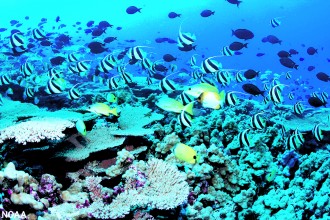The Young Scientist
The Young Scientist
February 10, 2023By AILEEN O’CATHERINE

Coral reefs are often called the rainforests of the sea because they are teeming with a diversity of life forms. Think of them as an ocean habitat. Scientists estimate about 25 percent of marine species live in or around coral reefs, making them important placeholders for marine biodiversity. There are so many life forms in coral reefs that scientists have not identified them all, discovering new species every year. Coral reefs are like nurseries for many fish species. In the movie “Finding Nemo,” a clownfish named Marlin searches for his lost son Nemo in their coral reef home, which is teeming with other fish and marine creatures.
Lots of fish can be found in coral reefs including cuttlefish, lionfish, sharks, pufferfish and eels. Sea animals such as sponges, anemones, starfish, sea cucumbers, snails and clams attach themselves to coral reefs. Sea plants found in coral reefs include seaweed, sea grasses and algae.
Coral reefs are most often associated with warm, shallow waters, but there are deep sea coral reefs as well. Because coral reefs are hard, you might think they are made of rocks. Coral reefs are made up of live organisms that are small animals called polyps. The polyps live on the outside of the reef, and as they die, they become hard. The new polyps grow on top of the hard reef, which makes it grow. Polyps eat small animals called plankton and an algae called zooxanthellae (zoo-zan-thel-ay). The algae live inside the hard coral skeletons that are made of calcium carbonate (limestone or chalk). In return for that protection, the algae provide their host with food produced through photosynthesis. The sunlight feeds the algae, the algae feed the polyps and the polyps become coral reefs.
This symbiotic relationship (a relationship where each cooperates with the other) depends on the temperature of the surrounding water. When the temperature of the water becomes too warm for the algae, the reef becomes white, something called coral bleaching. The living algae gives coral its color. Reefs can recover if the water becomes cooler, so maintaining the right water temperature is key as we face the challenges of global warming. Warmer ocean water is also more acidic than normal, which makes it harder for corals to build their exoskeletons or hard forms. Ocean warming results from higher levels of carbon dioxide (CO2) in the water. The ocean absorbs CO2, which also makes the water more acidic, making it harder for the coral to grow. Deep sea corals live in the deep cooler parts of the ocean. Since zooxanthellae algae does not live in these depths, deep sea corals eat plankton and other organic matter.
Most coral reefs are found in southeast Asia and near Australia. The Great Barrier Reef is off the coast of Australia’s Queensland and is so large it can be seen from outer space. Barrier reefs are miles away from a shoreline, but fringe reefs can be attached to the shore or near a lagoon. Another kind of reef is called an atoll. This reef is a ring of coral that surrounds a lagoon and starts out as a fringe reef around a volcanic island. Most coral reefs are 5,000 to 10,000 years old. Their fossilized ancestors date back hundreds of millions of years.

